 by John Malloy | Contributing Editor
by John Malloy | Contributing Editor
The Ruger Model 10/22 semi- automatic carbine turns 50 this year! Introduced back in 1964, the handy, well-made .22-caliber carbine gained immediate approval in the shooting world. Minor variations came and went during the next half-century, but the basic design remained virtually unchanged.
To celebrate this anniversary, 10/22 rifles made during 2014 will come in commemorative boxes and have specially marked bolts and receivers. To celebrate its 50-year anniversary, Ruger began a contest to determine what sort of limited- production special 10/22 should be offered. A special “Contest Winner” 10/22 was created, and is now available.
The company will be glad to provide information on this new rifle, and all their other product lines. Contact Sturm, Ruger & Co. at rugerfirearms.com. To home in specifically on the 10/22 offerings, visit: ruger.com/10/22.
Consider the 10/22’s place in history. 1964 was a turbulent time for the introduction of a new firearm. The murder of President John F. Kennedy on Nov. 22, 1963 had given rise to a politically- inspired and media-sustained anti-gun movement in the United States. The Ruger 10/22, introduced early in 1964, came into that environment.
Sturm, Ruger & Company had started in 1949 with a single product, the .22-caliber Ruger “Standard” semi-automatic pistol. Its introductory price of $37.50 remained constant for the next 15 years. By 1963, the company’s product line had grown to also include the Mark I target pistol, and a line of single-action revolvers. The short-lived single- shot Hawkeye pistol (based on a revolver frame) completed the company’s handgun lineup.

Accuracy shooting was done from the bench with a bedroll rest, Malloy’s favorite shooting rest. This arrangement allows the rifle to be fired with a normal hold. Accuracy with all available ammunition was very good.
All Ruger’s guns were handguns, except for one rifle—a .44 Magnum carbine that had been introduced in 1961 as the Deerstalker. By combining the general size and shape of an M1 Carbine with the effectiveness of the increasingly- popular .44 Magnum cartridge, Ruger created a useful woods rifle for deer hunting. In 1963, Ruger’s only rifle was the .44 carbine, renamed the Model 44.
Company founder William H. Ruger had worked with designer Harry Sefried on a new .22-caliber carbine that would look like the .44-caliber carbine, a companion piece to the larger-caliber rifle. Appearance of the .44 and .22 carbines was similar. The .22 carbine, however, was of simple blowback operation, and the receiver was made of aluminum. Instead of being screwed in, the barrel was drawn into the front of the receiver by a dual-screw V-block clamp. Bill Ruger had been an admirer of the rotary magazine of the Savage 99 rifle, and the new carbine was equipped with a detachable 10-shot rotary magazine. It lay flat in the lower line of the rifle’s stock for easy carrying. The magazine was a splendid piece of engineering, unlike anything used with .22 caliber rifles before. The name of the new carbine combined the magazine capacity and the caliber. It was offered as the 10/22.
The new 10/22 carbine had an 18½-inch barrel. The overall length was 37 inches, and the weight approximately 5 pounds. Sights were a folding adjustable rear leaf sight, with a gold-bead front sight. The original stocks were walnut. A special bolt lock was designed to secure the bolt open for cleaning, or while on a range.
Introduced at a retail price of $54.50 (which would remain constant for six years), the new 10/22 carbine was well-received. However, the political situation was changing.
Shortly after the death of President Kennedy, new president Lyndon B. Johnson stated his intention to carry out Kennedy’s programs. In some ways, such as the space program, he succeeded. In others, he divided the country. JFK’s New Frontier changed into LBJ’s Great Society. Military advisors to South Vietnam became the vanguard of an unpopular new full-fledged war.
The 1960s, which had started as an extension of the 1950s, ended as something very different. Rioting, looting and burning affected many American cities. A drug culture grew, and the crime rate soared. Anti-war protests became common.
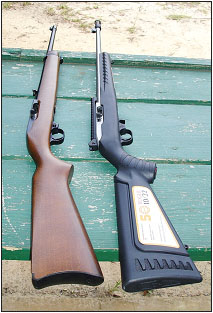
Two Ruger 10/22s on the range. An original carbine (left) provides comparison with the new 50th Anniversary “Contest Winner” rifle.
By 1969, America had indeed put a man on the moon, but family-oriented TV fare, such as “The Andy Griffith Show” was gone. The Beatles, who had also been introduced to America in 1964, began by offering harmonious versions of rock-and-roll classics. By the end of the decade, they were singing songs of protest and drug use.
Civil unrest and increased crime became intertwined with anti-gun politics. The murders of Rev. Martin Luther King (April 1968) and Robert Kennedy (June 1968) were used to justify the passage of the Gun Control Act of 1968 (GCA68). For the first time, ordinary firearms—and ammunition—were subjected to federal control.
In an environment in which new restrictions might be implemented, Ruger evaluated its product line. Most anti-gun proposals of that time were against handguns, and most of the company’s products were pistols and revolvers.
The 10/22 rifle line expanded. By 1967, a 10/22 Sporter ($64.50) and a 10/22 International ($74.50) joined the basic carbine. The Sporter had a checkered walnut stock with sling swivels. The International was stocked to the muzzle—Mannlicher-style. The Ruger line also broadened into centerfire falling-block single-shot rifles (1966) and bolt-action rifles (1968).
The 1970s
Richard M. Nixon was president for the period 1969-1974. A political environmental movement had grown up, and restrictions were placed on oil production. America became, for the first time, an oil importing country, with most of the oil coming from the Middle East.
In 1973, Arab producing countries established an oil embargo. US gasoline prices doubled, then tripled. Inflation ran rampant.
Accuracy shooting was done from the bench with a bedroll rest, Malloy’s favorite shooting rest. This arrangement allows the rifle to be fired with a normal hold. Accuracy with all available ammunition was very good.[/caption]
The dollar was worth less, and prices of everything rose. The 10/22 Carbine price increased each year, to $56.50 to $57.50 to $59.75. The International was discontinued. Nixon resigned in disgrace in 1974, and Gerald Ford became president. Ford was president during the humiliating end of the Vietnam War in 1975, when Saigon fell to the communists. However, Ford presided over the celebration of the US Bicentennial, which took place in 1976. Ruger added a commemorative legend to all 10/22s (and most other Ruger firearms) that were produced during 1976: “Made in the 200th Year of American Liberty.” These “Liberty” marked firearms are now desirable collector items.
James Earl “Jimmy” Carter became president in 1977. In 1979 the Arab oil producing states began another embargo, and inflation soared again. The price of a 10/22 Carbine rose to $107.50, just shy of double its original price. The 10/22 Sporter climbed to $128.50. The Shah of Iran was deposed, and in 1980, US Embassy personnel in Tehran were held hostage.
The 1980s
In January 1981, Ronald Reagan began his first term as US president. The American hostages in Iran were released. On March 30, 1981, Reagan was shot in an assassination attempt. While he was recovering, anti-gun forces attempted to use the situation to promote more firearms restrictions. Reagan, however, refused to blame firearms or lawful firearms use.
He was re-elected to a second term, 1985-1989. In 1986, the Firearms Owners Protection Act was passed, overturning some of the more onerous portions of the GCA68, and in 1987, Florida passed a “Shall Issue” concealed firearms law that became the model for many other states.
Inflation in the early ’80s was still a problem, and during 1983, Ruger initiated a cost-saving change. The 10/22 Carbine was made with a birch stock. The 10/22 Sporter retained a walnut stock. Prices were $134 and $163, respectively, and held constant for a few years. Shooters still liked walnut stocks, and by 1988, Ruger offered the 10/22 Carbine with a birch stock for $176 or a walnut stock for $196. The Sporter stayed with its walnut stock, at $222. After a few years, the walnut-stock Carbine was dropped again.
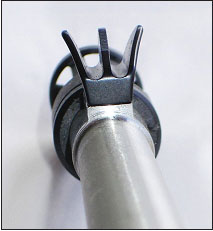
Look familiar? Those familiar with the M1 Garand or M1 Carbine will feel at home with the sights on the Contest Winner Ruger 10/22. The front sight is a flat-top post with protective wings.
The Berlin Wall was torn down in 1989, and two years later, the USSR had ceased to exist.
The 1990s
Reagan was succeeded as president by George H.W. Bush. Bush was in office from 1989 through January 1993. During Bush’s tenure, the 1990 “Gun Free School Zones” act was passed.
1992 was a notable year for the 10/22. It was the first offering of stainless-steel barrels. The aluminum receivers were polished or colored to match the barrels. The blued carbine was offered at $201.50, with the stainless-barrel version at $236.00. The Sporter stayed with a blue barrel at $254.50. Inflation was abating, and these prices were constant for several years.
William Jefferson “Bill” Clinton succeeded George Bush in the presidency, elected for the 1993-97 term and reelected for 1997-2001. Disturbing events for firearms owners ensued. In April 1993 Americans were shocked at the burning of the Branch Davidian living compound and school near Waco, TX. Dozens of people died in the siege that had been initiated on suspicion of federal firearms violations.
In September 1994, Clinton signed into law a federal crime bill generally known as the “Assault Weapons Ban.” For the first time, the sale, manufacture and importation of specific firearms, primarily semi-automatic rifles, were banned by name and by physical appearances. Legislated magazine capacity was reduced to 10 or fewer rounds.
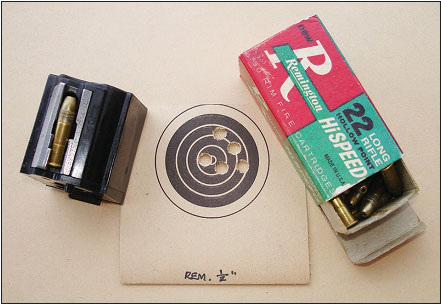
This five-shot group on an NRA 50-foot target measures just a little over
½ inch, not bad at all. However, it was fired at 25 yards with the new
Ruger commemorative rifle. Iron sights, bedroll rest. All ammunition
tried shot very well in the rifle.
Ruger, concerned that semiautomatic rifles were being demonized and might be banned completely, had to face the possibility that the popular semiautomatic 10/22, sales of which had passed 3 million by 1993, might be a political target. The company developed a lever-action rifle.
Based on the Savage 99 and styled after the 10/22, the new rifle was introduced in 1996 as the Model 96. Although it was conceived as a sort of emergency replacement for the 10/22, Ruger designers liked it so well they added it to the line, even though additional attacks on semi-automatic rifles were not initiated then. The Model 96 was introduced in .22 LR and also made in .22 Magnum, 44 Magnum and .17 HMR.
By 1996, the basic wood-stocked Carbine, at $201.50, was still a good seller. A new Target model was offered, with a 20-inch heavy barrel, at $392.50. By 1999, a 10/22 Magnum was added to the line. With a steel receiver, it was heavier than the original. List price was $392.50.
In April 1999, deranged murderers committed suicide after killing schoolchildren at Columbine High School in Littleton, CO. The massive publicity that was generated essentially guaranteed that similar situations would occur in the future. By 2000, composite stocks, which had first been offered with the 10/22 All-Weather about 1997, were offered for the 10/22 carbine. A 10/22 carbine could be had with either a wood or composite stock for the same price, $225.
The New Millennium
Clinton was impeached for lying under oath, but remained in office for his full term. He was succeeded by George W. Bush, who served two terms, from 2001 through 2009.
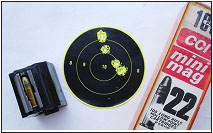
A five-shot group fired at 50 yards with the 10/22 measures about
1-3/8 inches. Iron sights, bedroll rest. This would not be a bad small- game rifle.
The relatively peaceful decade of the ‘90s, which had begun when the USSR ceased to exist in 1991 ended on Sept. 11, 2001. Highjacked airliners were flown into the Twin Towers of the World Trade Center in New York City and other locations. Thousands were killed. Americans realized that no one was safe from terrorist attacks.
In 2004, the “Assault Weapons Ban” of 1994 sunset, and was no longer in force. People were increasingly concerned with their safety, and sales of firearms rose. Sales of the 10/22 topped 4 million in 2004. That year was the 40th anniversary of the 10/22. The rifles made in 2004 had special “40 Year” markings, and were fitted with a clear plastic magazine with a red rotator. The commemoratives had a nickel silver medallion on the right side of the buttstock. In 2006, a “Compact” 10/22 was introduced, with a 16 ½-inch barrel and shorter stock. In 2008, a “Charger” 22 pistol was made, a large pistol based on the 10/22 action. 2008 was also the year of the landmark Supreme Court Heller case, which affirmed the right of Washington, DC, residents to keep and bear arms.

Ten years ago, in 2004, Ruger brought out the 40-year anniversary of the 10/22. New magazines made of clear plastic were featured at that time. This package was never opened.
Barack Obama was elected as president for a term beginning in 2009 and reelected for a second term starting in 2013. Because of his anti-gun record, his first term set off a surge of people purchasing firearms and ammunition.
The ending of the 10-year ban on firearms with exotic looks in 2004 had highlighted a built-up demand for firearms with such “tactical” appearance. American companies cautiously offered 22-caliber rifles that looked much like an AR-15 style rifle, and they became popular. About 2010, Ruger offered its SR-22 in that category. This new rifle was based on the dependable 10/22 action, but was designed to use accessories made for the AR-15. Recently, the company has offered a 25-round BX-25 extended magazine that would work, not only with the SR-22, but with all 10/22 rifles previously made.
During his first term, Obama avoided overt efforts to increase controls on firearms owners.
During the debates preceding his reelection, however, he made clear his determination to push for more controls. A second surge of buying of firearms and ammunition began before he took office. Ammunition especially became in very short supply, with .22-caliber rimfire ammunition very hard to find.
So, as we have seen, in a number of cases, the Ruger firm made decisions involving the 10/22 were related to current political or economic situations. Through it all, the 10/22 has been one of the company’s most popular items.
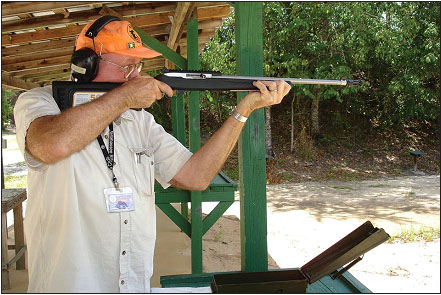
Malloy shot a number of targets from standing position to try out different loads. The rifle handles well from different positions.
What variety! With well over five million rifles produced over a 50- year span, the 10/22 has been offered by Ruger in numerous variants. Aftermarket components abound. It would be possible to find dozens of Ruger variants and thousands of owner-modified specialty rifles.
How does the 50-Year “Contest Winner” 10/22 stack up with other variants? A first inspection of the contest winning rifle is very positive.
It has a mixture of traditional and modern characteristics. Out of the box, it weighs just over 5 pounds. The stainless-steel barrel is 18¾ inches long. The threaded muzzle is equipped with a flash hider that brings the total barrel length to 20 ½ inches, and the overall length to 39 inches. The flash hider appears to be the same one used on Ruger’s 223-caliber rifles that are so equipped. Why a flash hider on a .22LR chambered rifle? A “tactical” look? Some believe that its main purpose is to call attention to the fact that the muzzle is indeed threaded, and thus offers potential for other attachments later. The flash hider has flats in its base that allow use of a ¾ inch (or 19mm) open-end wrench for removal or installation.
The stainless-steel barrel is matched in color by the silver- colored receiver. Matching the black of the composition stock, the trigger guard/trigger housing unit is traditional matte black. All the firing mechanism parts are enclosed in this unit. A Picatinny rail and simple receiver sight are mounted on the top of the receiver.

Extended ma gazines ha v e become very popular since the magazine restrictions of the “Assault Weapons Ban” have been lifted. Here, shooting companion Kirk Anderson shoots the 50th Anniversar y rifle with a long extended magazine.
The stock is black polymer and two interchangeable butt/comb units are provided. This allows a choice of a higher comb when using optical or electronic sights. The standard comb was just right for me with the supplied receiver sight.
The receiver sight has no disc, and offers the “ghost ring” aperture liked by many. The front sight is a post with protective wings. The sight picture will look familiar to anyone who has had experience with an M1 Garand or M1 Carbine.
The action is the traditional 10/22 action, not much changed since its introduction in 1964. It is a blowback, feeding cartridges from its unique 10-shot rotary magazine. The magazine latch was changed a few years ago to permit easy use of extended magazines for those who like the tactical look—or just like lots of shots for serious plinking or target shooting. Ruger now offers its 25-round BX- 25 extended magazine, which can hold 25 rounds for such purposes.
The Contest Winner 50th Anniversary rifle is an eye-catching rifle. How will it shoot right out of the box? Many nowadays immediately scope a rifle to find out how it will shoot. I was attracted to the iron sights supplied, which took me back to years of competition with the M1 rifle. It shot so well, I never got around to mounting a scope. During a number of range trips to shoot the Contest Winner at various distances, I got to know it better.
The rear sight is not a target sight, but the adjustments are simple. Windage adjustments are made by loosening a 5/64-inch (or 2mm) Allen-type hex set screw on one side and tightening the corresponding set screw on the other side. Elevation adjustments are made by turning the threaded stem of the aperture up or down.
Due to the ammunition shortage, I used a variety of .22 LR ammunition that came to hand. I was able to find both 36-grain hollowpoint and 40-grain solid loads by Remington, Federal, CCI and Winchester. Some had been in storage for some time, but everything shot well and functioned flawlessly. From a simple bedroll rest, the Contest Winner 10/22 shot very good groups with any ammunition tried. Many .22LR semi-automatics require high-velocity ammunition to work properly. I had some standard-velocity Remington target ammunition, and tried it in the new 10/22. Flawless functioning, excellent groups! Shooting from a rest, even an improvised one such as a bedroll, can tell you a lot about a rifle.
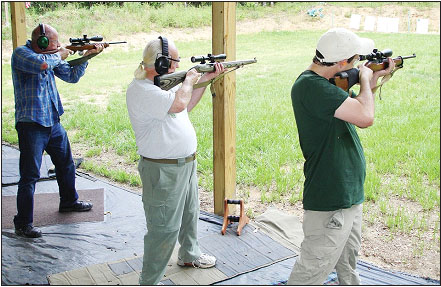
All three shooters at this range are using different types of Ruger 10/22
rifles, all with different aftermarket additions. One, at center, is a nice
International variant, stocked to the muzzle.
However, a semi-automatic .22 makes one want to try less formal positions and less formal targets.
Some close-range paper targets and plinking targets were enjoyed, but not recorded. When it appeared on a range, the Contest Winner 10/22 always attracted attention. Most people who saw it wanted to try it. It is a fun gun.
Commemorative firearms have gained a niche among firearms collectors. Some simply put away and never shoot the commemoratives they purchase. With the 50th Anniversary Contest Winner 10/22, that would be a shame. My test rifle functioned flawlessly with every type of ammunition I tried, and shot with very satisfactory accuracy. It was really a lot of fun. Not only is it an interesting collector item, it is perfectly suitable for small-game hunting, as a recreational shooter, or for one of the speed sports of .22 rimfire competitive shooting.
So, if you are attracted to the 10/22 Contest Winner rifle, and are not sure whether you like it as a collector item or as a shooter, what should you do?
Buy two.



